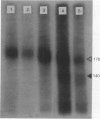Abstract
Characterisation of altered glycosylation of P-glycoprotein (P-gp) found associated with the absence of a multidrug resistance (MDR) phenotype in cell lines prompted an investigation to assess the role of post-translational processing in establishing P-gp efflux pump functionally. The clone A cell line used in this study displays a strong MDR phenotype mediated by high constitutive levels of expression of P-gp. Incubation of clone A cells with tunicamycin for different periods resulted in a time-dependent increase in daunorubicin accumulation, reflecting a reduction in P-gp function. Parallel experiments conducted with verapamil resulted in no loss of P-gp functionality in clone A cells. Reduction in surface-associated P-gp following exposure to tunicamycin was established by FACS analysis, Western blot analysis and immunoprecipitation of surface-iodinated P-gp. In addition, immunoprecipitation of P-gp from 32P-orthophosphate-labelled cells demonstrated reduced phosphorylation of P-gp associated with tunicamycin exposure. From these studies we conclude that glycosylation of P-gp is required to establish the cellular MDR phenotype.
Full text
PDF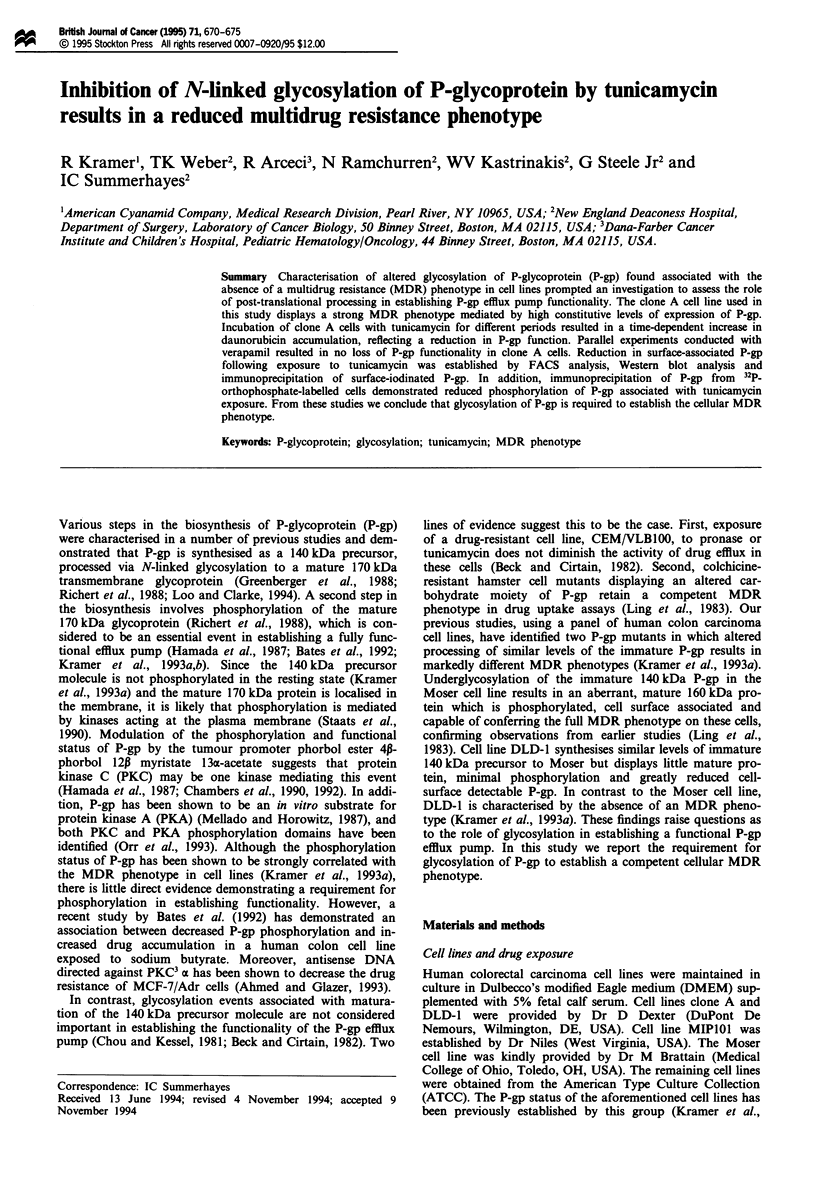


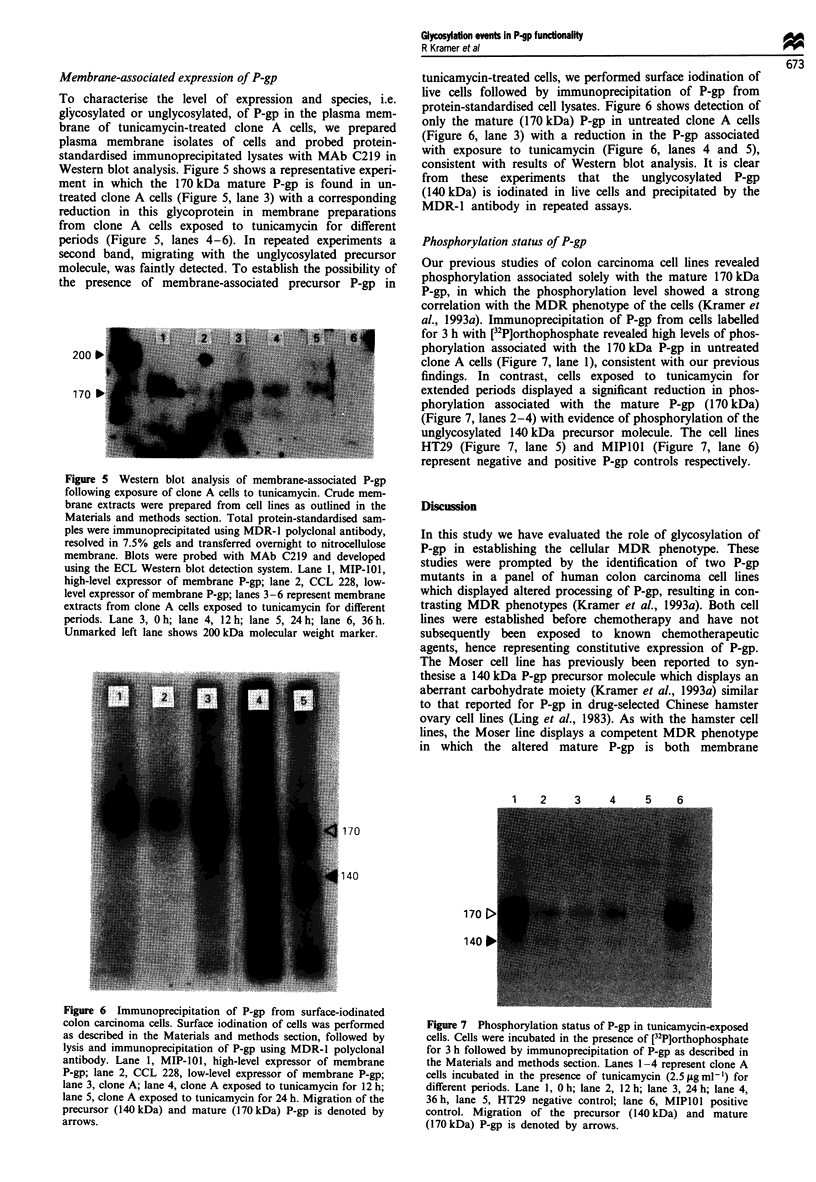
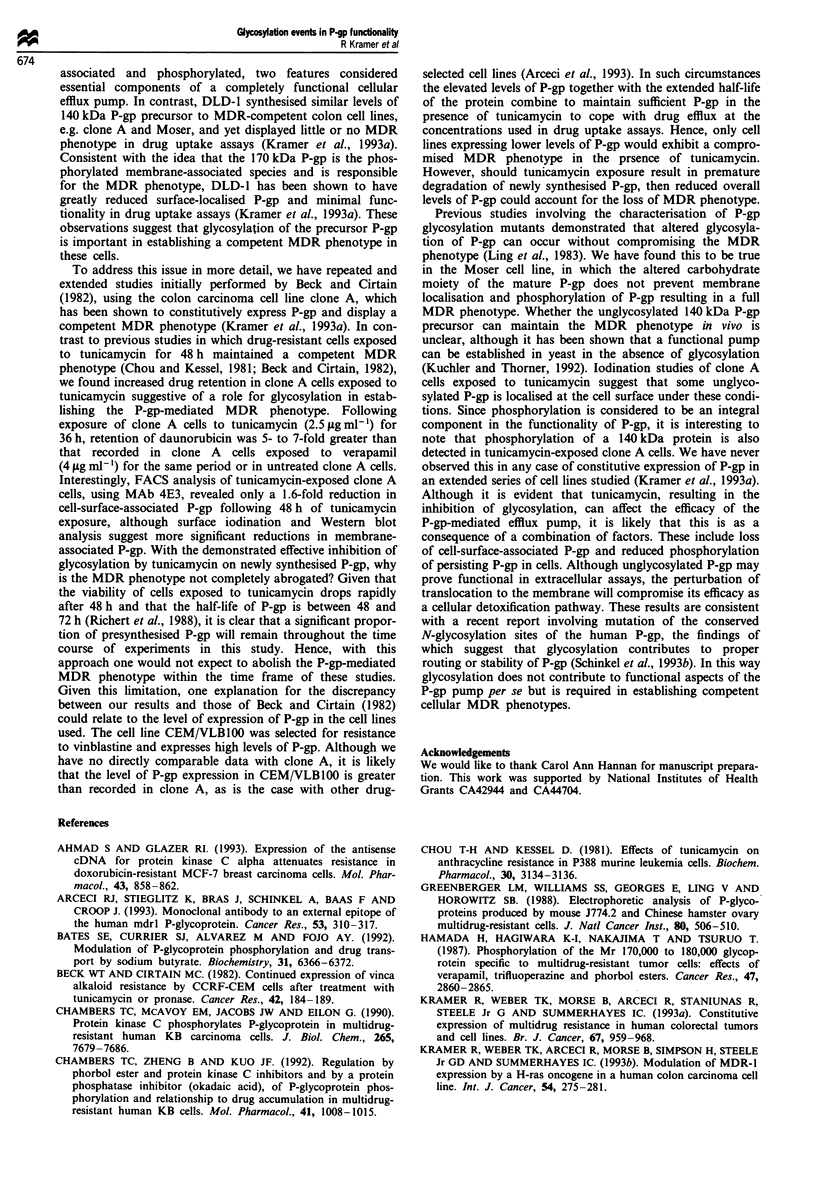
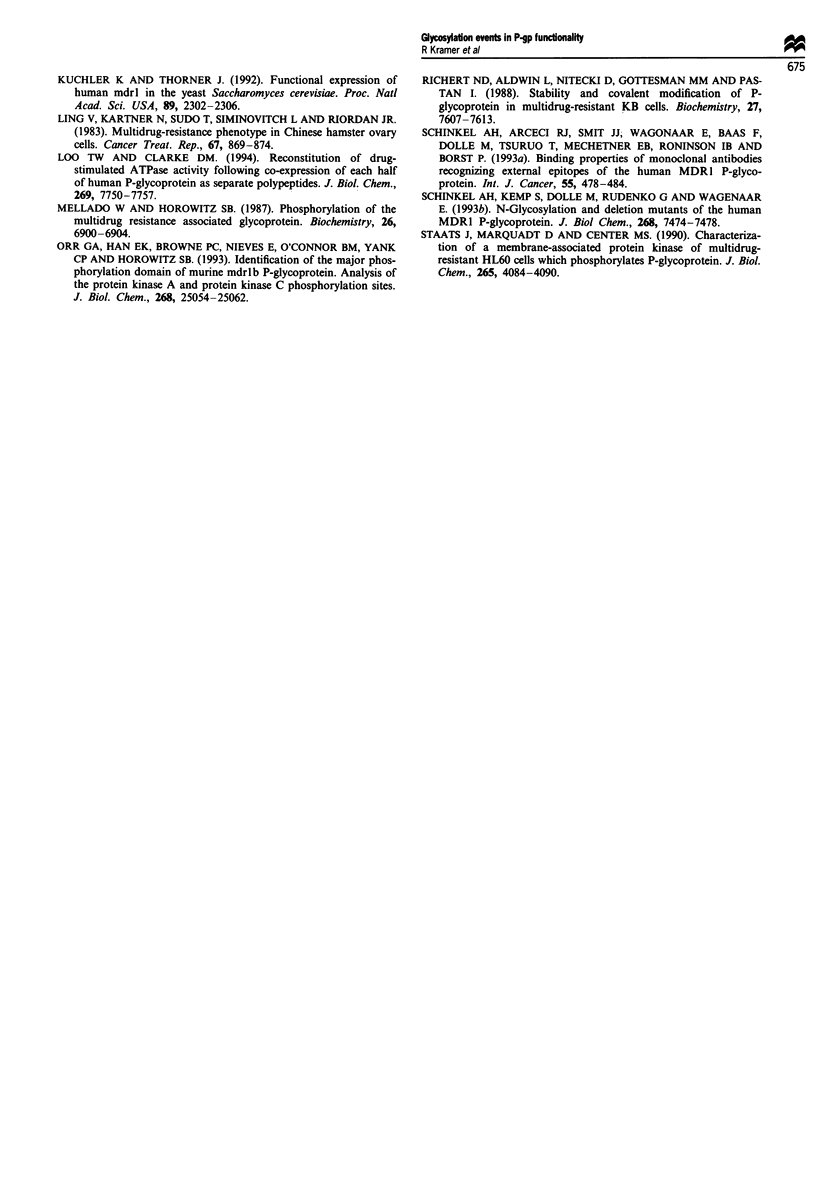
Images in this article
Selected References
These references are in PubMed. This may not be the complete list of references from this article.
- Ahmad S., Glazer R. I. Expression of the antisense cDNA for protein kinase C alpha attenuates resistance in doxorubicin-resistant MCF-7 breast carcinoma cells. Mol Pharmacol. 1993 Jun;43(6):858–862. [PubMed] [Google Scholar]
- Arceci R. J., Stieglitz K., Bras J., Schinkel A., Baas F., Croop J. Monoclonal antibody to an external epitope of the human mdr1 P-glycoprotein. Cancer Res. 1993 Jan 15;53(2):310–317. [PubMed] [Google Scholar]
- Bates S. E., Currier S. J., Alvarez M., Fojo A. T. Modulation of P-glycoprotein phosphorylation and drug transport by sodium butyrate. Biochemistry. 1992 Jul 21;31(28):6366–6372. doi: 10.1021/bi00143a002. [DOI] [PubMed] [Google Scholar]
- Beck W. T., Cirtain M. C. Continued expression of vinca alkaloid resistance by CCRF-CEM cells after treatment with tunicamycin or pronase. Cancer Res. 1982 Jan;42(1):184–189. [PubMed] [Google Scholar]
- Chambers T. C., McAvoy E. M., Jacobs J. W., Eilon G. Protein kinase C phosphorylates P-glycoprotein in multidrug resistant human KB carcinoma cells. J Biol Chem. 1990 May 5;265(13):7679–7686. [PubMed] [Google Scholar]
- Chambers T. C., Zheng B., Kuo J. F. Regulation by phorbol ester and protein kinase C inhibitors, and by a protein phosphatase inhibitor (okadaic acid), of P-glycoprotein phosphorylation and relationship to drug accumulation in multidrug-resistant human KB cells. Mol Pharmacol. 1992 Jun;41(6):1008–1015. [PubMed] [Google Scholar]
- Chou T. H., Kessel D. Effects of tunicamycin on anthracycline resistance in P388 murine leukemia cells. Biochem Pharmacol. 1981 Nov 15;30(22):3134–3136. doi: 10.1016/0006-2952(81)90509-8. [DOI] [PubMed] [Google Scholar]
- Greenberger L. M., Williams S. S., Georges E., Ling V., Horwitz S. B. Electrophoretic analysis of P-glycoproteins produced by mouse J774.2 and Chinese hamster ovary multidrug-resistant cells. J Natl Cancer Inst. 1988 Jun 1;80(7):506–510. doi: 10.1093/jnci/80.7.506. [DOI] [PubMed] [Google Scholar]
- Hamada H., Hagiwara K., Nakajima T., Tsuruo T. Phosphorylation of the Mr 170,000 to 180,000 glycoprotein specific to multidrug-resistant tumor cells: effects of verapamil, trifluoperazine, and phorbol esters. Cancer Res. 1987 Jun 1;47(11):2860–2865. [PubMed] [Google Scholar]
- Kramer R., Weber T. K., Arceci R., Morse B., Simpson H., Steele G. D., Jr, Summerhayes I. C. Modulation of mdr-1 expression by a H-ras oncogene in a human colon carcinoma cell line. Int J Cancer. 1993 May 8;54(2):275–281. doi: 10.1002/ijc.2910540219. [DOI] [PubMed] [Google Scholar]
- Kramer R., Weber T. K., Morse B., Arceci R., Staniunas R., Steele G., Jr, Summerhayes I. C. Constitutive expression of multidrug resistance in human colorectal tumours and cell lines. Br J Cancer. 1993 May;67(5):959–968. doi: 10.1038/bjc.1993.177. [DOI] [PMC free article] [PubMed] [Google Scholar]
- Kuchler K., Thorner J. Functional expression of human mdr1 in the yeast Saccharomyces cerevisiae. Proc Natl Acad Sci U S A. 1992 Mar 15;89(6):2302–2306. doi: 10.1073/pnas.89.6.2302. [DOI] [PMC free article] [PubMed] [Google Scholar]
- Ling V., Kartner N., Sudo T., Siminovitch L., Riordan J. R. Multidrug-resistance phenotype in Chinese hamster ovary cells. Cancer Treat Rep. 1983 Oct;67(10):869–874. [PubMed] [Google Scholar]
- Loo T. W., Clarke D. M. Reconstitution of drug-stimulated ATPase activity following co-expression of each half of human P-glycoprotein as separate polypeptides. J Biol Chem. 1994 Mar 11;269(10):7750–7755. [PubMed] [Google Scholar]
- Mellado W., Horwitz S. B. Phosphorylation of the multidrug resistance associated glycoprotein. Biochemistry. 1987 Nov 3;26(22):6900–6904. doi: 10.1021/bi00396a005. [DOI] [PubMed] [Google Scholar]
- Orr G. A., Han E. K., Browne P. C., Nieves E., O'Connor B. M., Yang C. P., Horwitz S. B. Identification of the major phosphorylation domain of murine mdr1b P-glycoprotein. Analysis of the protein kinase A and protein kinase C phosphorylation sites. J Biol Chem. 1993 Nov 25;268(33):25054–25062. [PubMed] [Google Scholar]
- Richert N. D., Aldwin L., Nitecki D., Gottesman M. M., Pastan I. Stability and covalent modification of P-glycoprotein in multidrug-resistant KB cells. Biochemistry. 1988 Oct 4;27(20):7607–7613. doi: 10.1021/bi00420a006. [DOI] [PubMed] [Google Scholar]
- Schinkel A. H., Arceci R. J., Smit J. J., Wagenaar E., Baas F., Dollé M., Tsuruo T., Mechetner E. B., Roninson I. B., Borst P. Binding properties of monoclonal antibodies recognizing external epitopes of the human MDR1 P-glycoprotein. Int J Cancer. 1993 Sep 30;55(3):478–484. doi: 10.1002/ijc.2910550326. [DOI] [PubMed] [Google Scholar]
- Schinkel A. H., Kemp S., Dollé M., Rudenko G., Wagenaar E. N-glycosylation and deletion mutants of the human MDR1 P-glycoprotein. J Biol Chem. 1993 Apr 5;268(10):7474–7481. [PubMed] [Google Scholar]
- Staats J., Marquardt D., Center M. S. Characterization of a membrane-associated protein kinase of multidrug-resistant HL60 cells which phosphorylates P-glycoprotein. J Biol Chem. 1990 Mar 5;265(7):4084–4090. [PubMed] [Google Scholar]






